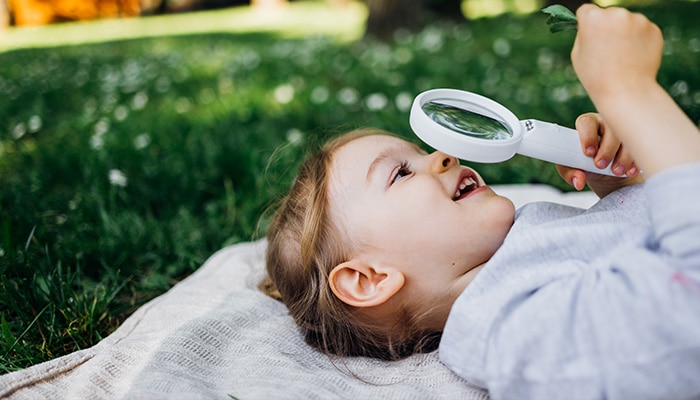While we believe that the books and resources recommended may be of value to you, keep in mind that these are suggestions only and you must do your own due diligence to determine whether the materials are appropriate and suitable for your use. PNC has no sponsorship or endorsement agreement with the authors or publishers of the materials listed.
OUTDOOR CLASSROOM

Nature in Our Backyard
Children will explore nature.

Lesson Objective
Children will explore the natural plants and animals found outside the school, collect naturally found objects, and create nature squares.
ScienceArt
What You'll Need
- Blanket(s) or other mats for sitting outside
- Outdoor space to explore
- Paper or plastic bags – 1 per child
- Magnifying glasses
- Clear contact paper – 2 sheets (about 6" x 6") per child (available in rolls at office supply and discount stores)
- Yarn – 12" length per child
What To Do
- Tell the children that they will be going outside to explore nature.
- Take the children outside, and have them sit on the blankets that you have spread on the ground.
- Have the children use their senses to find signs of nature (see Guiding Student Inquiry).
- Distribute bags, and tell the children that they will be collecting items from nature to examine (see Lesson Tips).
- Tell the children that some things in nature are easy to see, such as a tree, leaf, or flower. Some things are very small, such as a seed or insect, and students will need to look closely to find them.
- Allow time for the children to explore and to choose a variety of items to put in their bags.
- Go back inside, distribute magnifying glasses, and have the children examine and share their findings.
- Have the children carefully arrange their items in a display.
- Distribute 1 contact paper square per child, peel the backing off the paper, and lay it on the table so the sticky side is up.
- Tell the children to place the items on the sticky side of the paper (see Lesson Tips).
- Tie a length of yarn in a loop, and attach it to the top of the contact paper.
- Peel the backing off a second sheet of contact paper, and match the sticky side of this second sheet to the sticky side of the first sheet, making a “sandwich” with the nature items in between.
- Hang the nature square artwork in the classroom.
Resources
Home School Resources
Home educators: use these printable lesson PDFs to teach this lesson to your home schoolers. They're available in English and Spanish.
Content Provided By
Common Core State Standards Initiative – These lessons are aligned with the Common Core State Standards ("CCSS"). The CCSS provide a consistent, clear understanding of the concepts and skills children are expected to learn and guide teachers to provide their students with opportunities to gain these important skills and foundational knowledge [1]. Visit the CCSS


